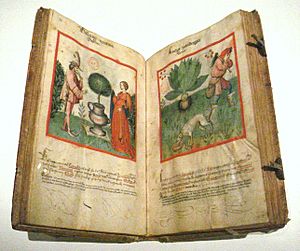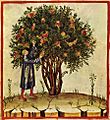Tacuinum Sanitatis facts for kids

Ibn Butlan's Tacuinum sanitatis, Rhineland, 2nd half of 15th c.
|
|
| Author | Ibn Butlan |
|---|---|
| Original title | Taqwīm as‑Siḥḥa |
| Country | Baghdad under Abbasid Caliphate |
| Language | Arabic |
| Subjects | health and wellbeing |
| Genres | medical |
|
Publication date
|
11th century |
| Text | Tacuinum Sanitatis online |
Taqwīm aṣ‑Ṣiḥḥa (تقويم الصحة Maintenance of Health) is an old book from the 11th century. It was written in Arabic by a doctor named Ibn Butlan from Baghdad. In Europe, people know it by its Latin name: Tacuinum (or Taccuinum) Sanitatis.
This book is like a medieval guide to staying healthy. It was made for educated people who weren't doctors. Many copies were made in Europe during the 14th and 15th centuries. These copies often had lots of pictures, so some people called it a "picture book" about health.
History of the Book
The original Taqwīm as‑Siḥḥa was copied in Arabic in 1213. One special copy was made for al-Malik al-Ẓāhir, who was the son of Saladin. This copy is now kept in the British Library.
Later, around the mid-13th century, the book was translated into Latin. This happened in places like Palermo or Naples in Italy. These cities were important meeting points where Islamic and European cultures shared ideas peacefully. One translation was even made for King Manfred of Sicily between 1254 and 1266.
Many beautiful copies of the Tacuinum with pictures were made in the late 14th century. These copies came from a region in Italy called Lombardy. Today, you can find these old books in cities like Vienna, Paris, Liège, and Rome. The Tacuinum was first printed as a book in 1531.
The Tacuinum was very popular in Europe during the Late Middle Ages. You can still see its influence today! The word taccuino in modern Italian means "notebook."
This book is important for understanding medieval medicine. It also teaches us about old farming methods and cooking. For example, it has one of the earliest pictures of a carrot! Carrots also appeared in older Greek plant encyclopedias.
What's Inside the Book
The Tacuinum Sanitatis is more than just a book about plants. It describes how different foods and plants can be helpful or harmful. It doesn't list things in ABC order. Instead, it talks about six key things needed for good health:
- Eating and drinking enough, but not too much.
- Breathing fresh air.
- Having a good balance of activity and rest.
- Getting enough sleep and being awake when needed.
- Making sure your body's natural fluids (called humours back then) are balanced.
- How your feelings and mood affect your health.
The book explains that if these six things are out of balance, you might get sick.
Different versions of the Tacuinum Sanitatis have various plant-based remedies. One collection of the book's text includes forty-eight different vegetables, fruits, and even clothing materials. Each part of the book focuses on one remedy. It explains how it helps, what problems it might cause, how to avoid those problems, and its good qualities.
It can be tricky to know the exact type of plant mentioned because of differences in old copies and translation mistakes. However, we can still generally figure out the remedies. The books describe root vegetables, onions and garlic, leafy greens, melons, and other vegetables. They also talk about fruits from both cool and warm climates, nuts, flowers, and herbs. Sometimes, the plants are named with Arabic words, which makes identifying them harder.
Some of the vegetables mentioned include:
- Root vegetables: Radishes, turnips, and parsnips.
- Alliums (like onions): Onions, leeks, and garlic.
- Leafy vegetables: Kale, lettuce, and spinach.
- Cucurbits (like gourds): Cucumber, melon, watermelon, and bottle gourd.
- Other vegetables: Asparagus, cowpea, and eggplant.
Fruits are another big part of the book. These include:
- Temperate fruits: Grapes, apples, pears, peaches, and cherries.
- Subtropical fruits: Lemons and pomegranates.
Besides fruits and vegetables, the book also suggests other things as remedies. These include chestnuts, hazelnuts, roses, lilies, violets, sage, marjoram, and dill. This isn't a full list, as different copies of the book have slightly different remedies.
For each remedy, the book explains a few things. It describes the best way the plant should be for medicine, like the quality of its leaves. It tells you not only the good things the item does but also any possible dangers. This is a bit like how modern medicines list side effects. However, the book also suggests a way to lessen these dangers. Usually, there's also a picture of the item being described.
The detailed pictures in the book sometimes show farming in a slightly exaggerated way. For example, they might make plants look bigger than they are. But these drawings are still better than many other farming pictures from that time. Many images show people harvesting crops instead of giving the medicine. So, the book also teaches us about farming alongside its medical advice. However, the quality of the drawings can make it hard to tell exactly which plant species is shown.
Images for kids
-
Harvesting garlic, from Tacuinum Sanitatis, c. 1400 (Bibliothèque nationale, Paris)]]
See also
 In Spanish: Tacuinum sanitatis para niños
In Spanish: Tacuinum sanitatis para niños



